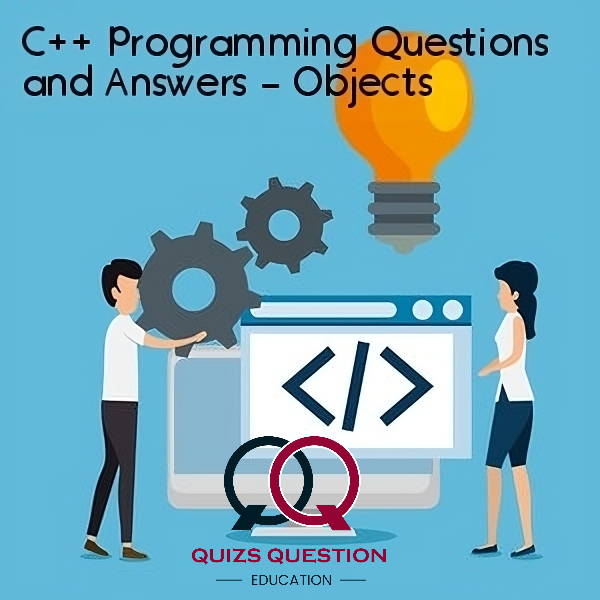C++ Multiple Choice Questions focuses on “Objects”. One shall practice these questions to improve their C++ programming skills needed for various interviews , placements, entrance exams and other competitive exams. These questions can be attempted by anyone focusing on learning C++ programming language. They can be a beginner, fresher, engineering graduate or an experienced IT professional. Our C++ questions comes with the detailed explanation of the answers which helps in better understanding of C++ concepts.
C++ Questions & Answers focuses on “Objects” along with answers, explanations and/or solutions:
Q 1. Where does the object is created?
A. class
B. constructor
C. destructor
D. attributes
Show Answer
Answer:-A. classExplanation
In class, only all the listed items except class will be declared.Q 2. How to access the object in the class?
A. direct member access operator
B. ternary operator
C. scope resolution operator
D. resolution operator
Show Answer
Answer:-A. direct member access operatorExplanation
Objects in the method can be accessed using direct member access operator which is (.).Q 3. Which of these following members are not accessed by using direct member access operator?
A. public
B. private
C. protected
D. both private & protected
Show Answer
Answer:-D. both private & protectedExplanation
Because of the access is given to the private and protected, We can’t access them by using direct member access operator.Q 4. Which special character is used to mark the end of class?
A. ;
B. :
C. #
D. $
Show Answer
Answer:-A. ;Explanation
Similar to ending any statement, a class is also terminated with semicolon(;).Q 5. Pick out the other definition of objects.
A. member of the class
B. instance of the class
C. attribute of the class
D. associate of the class
Show Answer
Answer:-B.instance of the classExplanation
An Object represents an instance of a class i.e. a variable of that class type having access to its data members and member functions from outside if allowed.Q 6. How many objects can present in a single class?
A. 1
B. 2
C. 3
D. as many as possible
Show Answer
Answer:-D. as many as possibleExplanation
Because a class may contain any number of objects according to its compliance.Q 7. What will be the output of the following C++ code?
#include <iostream>
using namespace std;
class sample
{
private:
int var;
public:
void input()
{
cout << var;
}
void output()
{
cout << “Variable entered is “;
cout << var << “\n“;
}
};
int main()
{
sample object;
object.input();
object.output();
object.var();
return 0;
}
A. Enter an integer 5
Variable entered is 5
B. Runtime error
C. Error
D. Enter an integer 7
Variable entered is 7
Show Answer
Answer:-C. ErrorExplanation
There is no member function var() in the class hence the program will through an error stating var is a private data member and it cannot be used as a function.Q 8. What will be the output of the following C++ code?
#include <iostream>
using namespace std;
class number
{
int i;
public:
int geti();
void puti(int j);
};
int number::geti()
{
return i;
}
void number::puti(int j)
{
i = j;
}
int main()
{
number s;
s.puti(10);
cout << s.geti( );
return 0;
}
A. 8
B. 10
C. 21
D. 26
Show Answer
Answer:-B. 10Explanation
We are getting the number and copying it to j and printing it. Output: $ g++ obj2.cpp $ a.out 10Q 9. What will be the output of the following C++ code?
#include <iostream>
using namespace std;
class Rect
{
int x, y;
public:
void set_values (int,int);
int area ()
{
return (x * y);
}
};
void Rect::set_values (int a, int b)
{
x = a;
y = b;
}
int main ()
{
Rect recta, rectb;
recta.set_values (5, 6);
rectb.set_values (7, 6);
cout << “recta area: ” << recta.area();
cout << “rectb area: ” << rectb.area();
return 0;
}
A. recta area: 30 rectb area: 33
B. recta area: 20 rectb area: 34
C. recta area: 30 rectb area: 21
D. recta area: 30 rectb area: 42
Show Answer
Answer:-D. recta area: 30 rectb area: 42Explanation
We are calculating the area of rectangle by two objects.Q 10. What will be the output of the following C++ code?
#include <iostream>
using namespace std;
class Box
{
public :
double length;
double breadth;
double height;
};
int main( )
{
Box Box1;
double volume;
Box1.height = 5;
Box1.length = 6;
Box1.breadth = 7.1;
volume = Box1.height * Box1.length * Box1.breadth;
cout << “Volume of Box1 : ” << volume <<endl;
return 0;
}
A. 210
B. 213
C. 215
D. 217


Leave a Reply